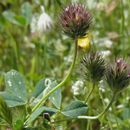en
names in breadcrumbs


Trifolium albopurpureum is a species of clover known by the common name rancheria clover.[1]
It is native to the west coast of North America from British Columbia, California and the Sierra Nevada, to Baja California. It can be found in a wide variety of habitats, including chaparral and woodlands, grasslands, forests, and montane locales.
Trifolium albopurpureum is an annual herb growing decumbent or erect in form. The leaflets are 1 to 3 centimeters long, and the herbage is hairy. The inflorescence is a spike of flowers measuring 0.5 to 2 centimeters wide. Each flower has a calyx of sepals with narrow lobes that taper into a bristle-shaped point and are coated in long hairs. Within the calyx is the flower corolla, which is purple and white in color.
Trifolium albopurpureum is often discussed as comprising three varieties. These are:
Trifolium albopurpureum is a species of clover known by the common name rancheria clover.
It is native to the west coast of North America from British Columbia, California and the Sierra Nevada, to Baja California. It can be found in a wide variety of habitats, including chaparral and woodlands, grasslands, forests, and montane locales.